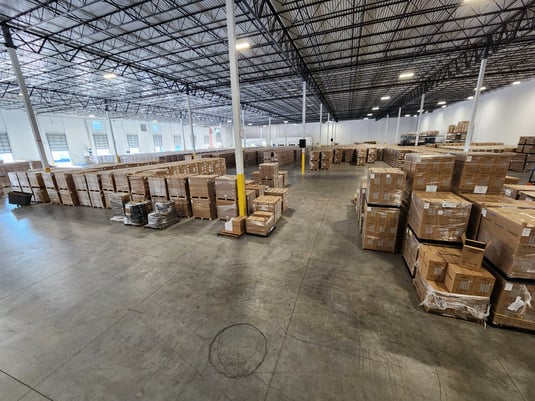To state the obvious, the time between 2020 and 2022 was weird. People went inside and stayed inside, yielding massive boosts in sales for companies based on virtual services, while others who rely on face-to-face interactions to provide services were left struggling. This was most evident in industries such as fitness and home gym. But now society is returning to in-person activities. With so many temporary spikes in sales intertwined with a general uncertainty of post-pandemic consumer behavior and a supply chain that is unstable at unprecedented levels, the historical purchasing data many analysts would once consider when demand forecasting has been rendered essentially ineffective.

Challenges & Consequences for Buyers
Supply Chains Are Longer Than You May Realize
Poor consumer data isn’t the only reason providing a solid forecast to your manufacturer is more difficult than ever before. As most of us have experienced by now, finding the materials you need in the time, quantity and price you desire, takes a stacked Rolodex, a little bit of magic, and a lot of patience. Customers used to be able to simply place an order with their manufacturer for 10,000 units of a finished good, for example, and soon enough the finished goods were being delivered. However, now that components and other materials are scarce, buyers who make unplanned forecast cuts are getting a crash course in exactly how long their supply chain really is.
Let’s say a customer works with their manufacturer to build a product that requires a rubber button. The manufacturer then gets in contact with their 3rd party supplier to secure the part, and that supplier works with their supplier to provide the raw materials, and so on…Think of it like an accident on the highway. This happens with every piece that goes into a finished good, so you can see how agreeing to a reduction in forecast with the manufacturing partner does not mean the suppliers along the entire chain will agree to cancel orders without a fee.
The Choice Between Time or Money: Brokers versus Distributors and PPV
Standard practice for EMS providers is to purchase components from a distributor. However, ongoing shortages have pushed buyers to allow their manufacturer to work with brokers to secure hard-to-come-by materials. Unfortunately, this method comes with a steep purchase price variance (PPV) which is then passed back to the buyer. Now there is a choice to be made. You can either get your part from a supplier at five cents, but it will take 97 days to receive it, or you can take your chances with a broker, pay a premium, and get what you need now. On top of the high cost, brokers sell to the highest bidder and are known to withdraw from their agreement because someone else offered more at the last minute.
Rising Standard of (MPPAs) Material Procurement Purchasing Agreements and Other Contracts

As further evidence of the trickle-down effect stemming from material shortages, increasing inventory is leading to cash flow problems across industries. Many EMS providers are drawing a harder line than in the past regarding holding materials while waiting for remaining components to arrive, and Material Procurement Purchasing Agreements (MPPAs) are becoming more common.
As an example, a manufacturer places an order for its customer’s printed circuit board that contains 105 parts. Luckily, 103 of those parts arrive on time, but the last 2 parts are delayed for another 3 months. In the past, situations like this were less common so suppliers were willing to hold those materials for its customers, but with delays in components more prevalent, inventory restraints for many manufacturers are less willing to tie up cash indefinitely and will be limiting raw material build up. In these cases, customers may see two scenarios. Either the manufacturer will not accept the rest of the materials early, or they will agree to hold the excess material for a fee. Additionally, more and more suppliers are requiring new customers to sign MPPAs before agreeing to start a project, which protects the supplier from bearing the financial burden of stagnant inventory over a certain period of time.
Best Practices for Better Forecasting
Communicate quickly and often.
- Be proactive. If you are not already providing a forecast to your manufacturing partner, that is step one. Don’t wait for them to ask for one.
- If you already have a set cadence for your forecast updates, consider increasing the frequency. Perhaps instead of a quarterly review, you can provide monthly or bi-weekly revisions. This will allow your supply chain partner to work from your most up-to-date numbers and better plan for any component inventory issues. Even with scheduled forecasting updates, do not wait for your regular update to inform your supplier of big changes. Communicate immediately so they can work with their material providers as best as possible.
- Now, communication should not be one-sided. Ensure you are working with a manufacturing partner who excels at communicating with customers where any potential problems may lie. For example, changes from their material providers are often last-minute and you want to make sure your manufacturer is both keeping you aware of changes as soon as they happen and proactively providing solutions.
Consider the consequences of orders that cannot be canceled.
It can be tempting to over-order parts to stockpile as a safety net but don’t forget what we discussed above. The supply chain is long, and the rules on cancellations are more rigid than ever. Forecasting changes may mean that you find yourself with excess materials, a large invoice for holding them, and an overall decreased gross margin.
Pay attention to the news and be proactive.
With historical data unreliable, consumer behavior more unpredictable than ever before, and rumblings of a recession, the news may be one of the best resources for forecasting analysts. We love a good example, so let’s examine the great oil price hike of 2022.
In January of 2022, crude oil was $86.51 per barrel. Only two months later in March or 2022, prices began to soar reaching $123.21 per barrel due to a slue of geopolitical and economic factors. A buyer who keeps an eye on the news would have been able to anticipate the forthcoming hike in cost to manufacture parts reliant on petroleum such as resin for plastic injection molded parts. This savvy buyer could have been proactive in increasing their forecast to their plastics supplier, locked in lower prices for these crucial parts, and saved their company a lot of money.
Oil prices may be coming down, but there are already rumblings of future global economic downturns that could have a great impact on the price of materials. Stay updated on the latest news and be thoughtful about how these events could affect other areas of the world to avoid surprises. Here are a few sources to start you off:
Prioritize the market before internal political pressures.
We have talked a lot about how external factors relate to forecasting. However, many times internal forces have significant influence on how buyers are purchasing. The Board of Directors may put pressure on executives to set arbitrarily high annual sales goals, though market trends suggest much different expectations. It is important for analysts to, as best they can, prioritize the market over internal office politics to avoid many of the financial consequences we discussed earlier.
At the end of the day, accurate forecasting is incredibly important for the financial well-being of all companies but also exceptionally difficult to do well. Fold in two years of unexpected surges and dips in sales trends, a supply chain that is hanging on by a thread, stagnant inventory, and a looming “will it/won’t it?” global recession; It’s no wonder analysts and buyers feel lost. We may not be able to help you predict the future, but by considering the approaches outlined above, hopefully you will be better able to quickly navigate the inevitable ups and downs of manufacturing while we all work to get to the other side of life after a pandemic.
Free RFQ Checklist
We have created a free RFQ checklist to help you put together a thorough package that will save you from too many back-and-forth e-mails, and get that quote back to you faster. Not to mention your potential supplier will love you for making their lives easier. Download your copy now to get started.





.jpg?width=176&height=56&name=MR_associatedNetwork_logo%20(1).jpg)